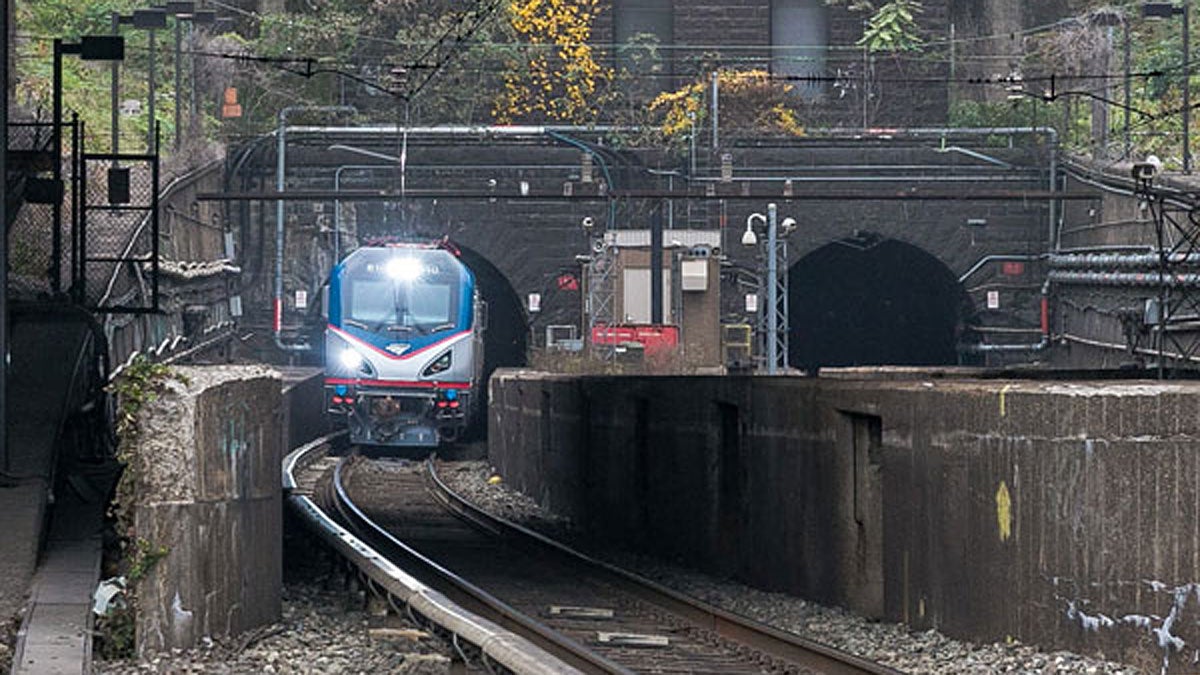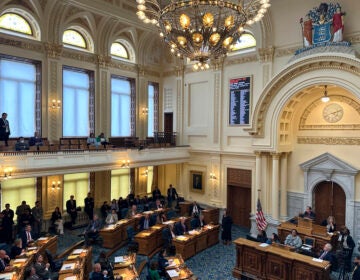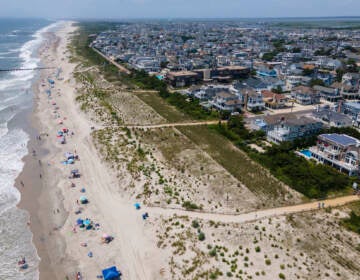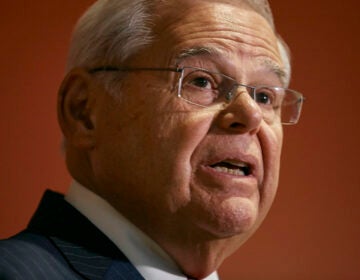Trump’s budget could freeze funding for the NJ/NY Gateway Tunnel project

(Photo by Chuck Gomez/Amtrak)
Work on a key bridge that’s part of the ambitious Gateway plan to build two new rail tunnels under the Hudson River is supposed to begin this year. But whether that will happen seems up in the air, as the initial preview of President Donald Trump’s first budget has put the project’s substantial federal funding in question.
Only a few sentences related to transportation spending are in a budget summary released by the White House last week, but they indicate the Trump administration plans to freeze new federal-grant agreements for infrastructure projects like Gateway that aren’t yet fully funded.
The budget proposal marks an apparent reversal by the Republican president on the issue of infrastructure after he repeatedly stressed the need to rebuild the nation’s “roads, bridges, railways, tunnels, sea ports, and airports” while on the presidential campaign trail in 2016. The project had been earmarked as the most important in the country by the Obama administration, since it not only impacts New York and New Jersey but the economy of the entire East Coast.
In response to a possible freeze, warnings are already being sent by federal lawmakers, transportation advocates, and even Gov. Chris Christie — who canceled New Jersey’s last major trans-Hudson tunnel project in 2010 — that there will be a major effort launched to save the funding for Gateway and keep its construction on track.
Early days for budget process
To be sure, the White House’s federal-spending outline marks only the beginning of a lengthy federal budget process that will also involve significant reshaping by Congress in the run-up to the October 1 start of the next fiscal year.
But time is of the essence for thousands of New Jersey commuters who rely on New Jersey Transit trains to get to jobs in New York since the existing tunnels are more than a century old, and have still yet to be fully repaired after significant damage was caused by floodwaters during 2012’s superstorm Sandy. The project is also expected to be a boon for New Jersey’s construction industry, with potentially thousands of jobs now hanging in the balance.
“New Jersey has so much at stake in just this one paragraph in the budget,” said Martin Robins, director emeritus of Rutgers University’s Alan M. Voorhees Transportation Center.
The most significant feature of Gateway — which has an estimated cost of between $20 billion and $25 billion — are two new tunnels running under the Hudson River between North Bergen and Penn Station. Once completed, the new tunnels would alleviate concerns about the havoc that an emergency shutdown of the existing tunnels would cause, and also help to ease the frequent delays that can occur for riders on NJ Transit and Amtrak trains, which share the same Amtrak-owned infrastructure. In all, the current tunnels support an estimated 200,000 daily train passengers.
But Gateway involves more than just fixing the tunnels; the plan also calls for a replacement of the century-old Portal Bridge near Secaucus Junction station and an expansion of Penn Station in New York City, along with other improvements. The entire project is considered to be vital to the region’s economic success, with a goal of doubling train capacity more than a decade from now.
Sharing costs equally
The current finance plan for Gateway involves an equal sharing of costs between the federal government, and New Jersey, New York, and the Port Authority. Earlier this year, the Port Authority set aside $2.7 billion in its latest 10-year capital plan to cover Gateway-project debt service.
Amtrak released a formal study last week that suggests spending on Gateway will be more than made up for in economic activity. The project is expected to create $3.87 in economic benefit for every $1 that’s invested, the study found.
John Porcari, interim executive director of the Gateway Program Development Corp., an agency that’s been set up to shepherd the project to completion, said the region right now represents about 10 percent of U.S. gross-domestic product, making Gateway “the most urgent infrastructure project in America.”
Porcari, a former U.S. deputy secretary of transportation, said preliminary work on the replacement of the Portal Bridge — which is a well-known chokepoint among commuters for its regular breakdowns — is slated to begin later this year, with the tunnel work “not far behind.” He also outlined a federal budget process that will now involve members of Congress, who ultimately have final say on what gets funded.
“On the merits of the project, we’re optimistic that this project will have federal funding,” he said.
Menendez objects
U.S. Sen. Robert Menendez (D-NJ) was among the federal lawmakers to immediately cry foul last week after Trump’s initial budget sketch was made public, saying the new approach to transportation spending “is “irresponsible, short-sighted, and demonstrates a complete failure of leadership.”
“A shutdown of the Northeast Corridor— which will be a reality without Gateway — will cost $100 million per day and will jeopardize a regional economy that contributes $3.7 trillion to the nation’s GDP,” Menendez said. “If this is truly the President’s priority — to cripple our transit network and our economy — I will fight him every step of the way to stop it.”
Christie press secretary Brian Murray also released a statement on Gateway, saying the governor would “do all he can to fight any federal funding cut to this project of regional and national importance.”
“New Jersey and New York are committed to funding their fair share,” Murray said.
It was Christie, a second-term Republican, who decided in 2010 to cancel construction that had already begun on the Access to the Region’s Core (ARC) project, which also involved building a new commuter-rail tunnel between New Jersey and New York. Christie justified his decision at the time on the potential for cost overruns ranging as high as $5 billion, but revenue set aside for the tunnel project was eventually used on transportation projects in New Jersey, helping Christie delay a gas-tax hike until after he won reelection in 2013.
Robins, a principal planner of ARC, said the region cannot afford to see any more delays to the tunnel-building effort given the condition the existing tunnels are now in after Sandy.
“We’re in a very risky situation,” Robins said. “Any delays could someday come back to haunt us.”
Strained budget resources
Greg Lalevee, chairman of the Engineers Labor-Employer Cooperative, said states like New Jersey don’t have the budget resources to shoulder such large-scale infrastructure projects on their own, as the White House spending plan suggests should be the case.
“If we’re going to compete and win in a global economy and deliver growth opportunities for future generations, we must invest in infrastructure,” Lalevee said.
Robins said Trump’s broader decision to deemphasize federal investment in transportation will have an impact on more than just Gateway. NJ Transit was hoping to get federal funding for other important projects, he said.
There’s also the issue of the planned replacement of the Port Authority’s overcapacity midtown Manhattan bus terminal. The bistate agency’s 10-year capital plan only partially funds the bus-terminal replacement, so if the existing rail tubes falter within the next decade there won’t be enough capacity at the bus terminal to pick up the slack for commuters who right now ride the rails.
“We have a potentially desperate situation,” Robins said. “It seems to me, the federal government is not mindful of how desperate it is.”
___________________________________________________________________
NJ Spotlight, an independent online news service on issues critical to New Jersey, makes its in-depth reporting available to NewsWorks.
WHYY is your source for fact-based, in-depth journalism and information. As a nonprofit organization, we rely on financial support from readers like you. Please give today.




